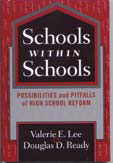Peeling Back the Layers in Schools within Schools [First Editions]
Is a growing movement creating gains for students?
The “schools within schools” (SWS) movement, which is sweeping New York City and other major urban public school systems, is a grassroots phenomena. Premised on the idea that adolescents learn best in small, thematically organized schools, the movement arose because parents and school officials lacked the tax base and political power to tear down existing large facilities and build new ones.
But does the SWS model make for more engaged students? Happier teachers? Higher test scores? Those are the questions asked by Douglas D. Ready, TC Assistant Professor of Education, and Valerie E. Lee of the University of Michigan in their new book, Schools Within Schools: Possibilities and Pitfalls of High School Reforms. Ready and Lee spent the past 10 years tracking students and faculty at five different schools that have integrated the SWS approach in varying ways.
Some of their answers are heartening: throughout the book, students and teachers alike say that SWS environments give rise to increased bonds of trust and mutual understanding and more positive social relations.
But on other measures, the record is less clear. The SWS model has not yet shown broad, across-the-board improvement in academic performance and test scores. Some people see the practice of dividing students into academically themed “sub-units” as ability tracking by another name—though Ready and Lee find that actual academic differences between the various sub-units are few. And, of course, no structural model is better than the people who implement it at a given school. Bottom line: as is the case with so many stories of school reform, Schools Within Schools offers a lot of good news but no silver bullet. Ultimately, the SWS schools “create the conditions under which innovation and change can flourish,” the authors write. “But such advances do not rise automatically.” The devil, as always, is in the details. z
Published Tuesday, Apr. 1, 2008
